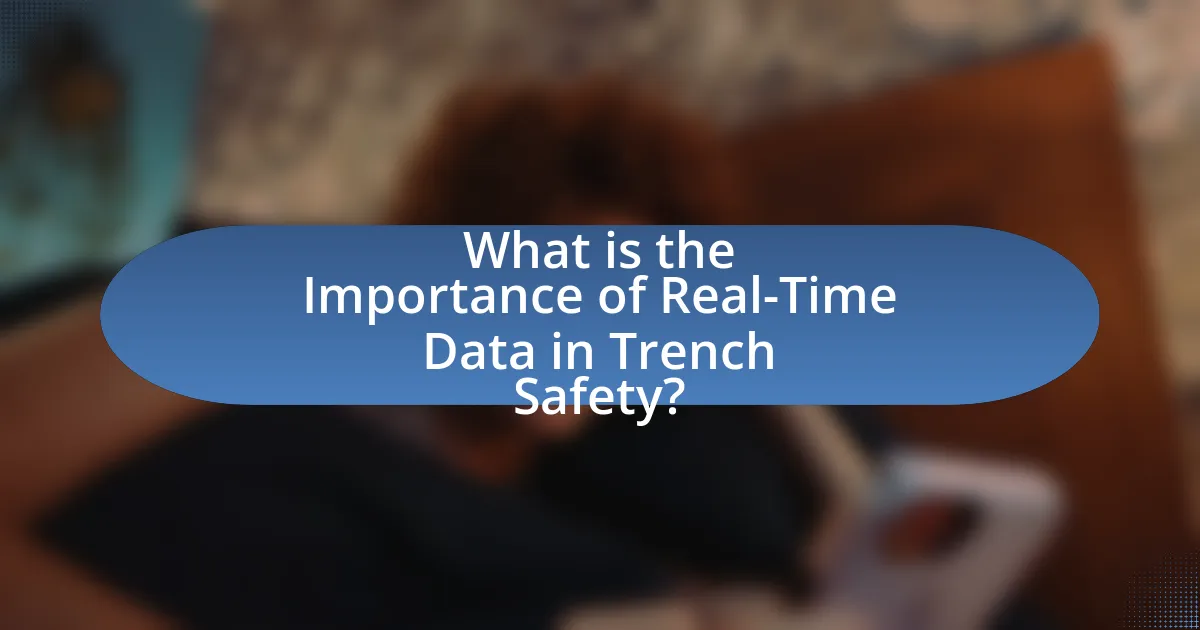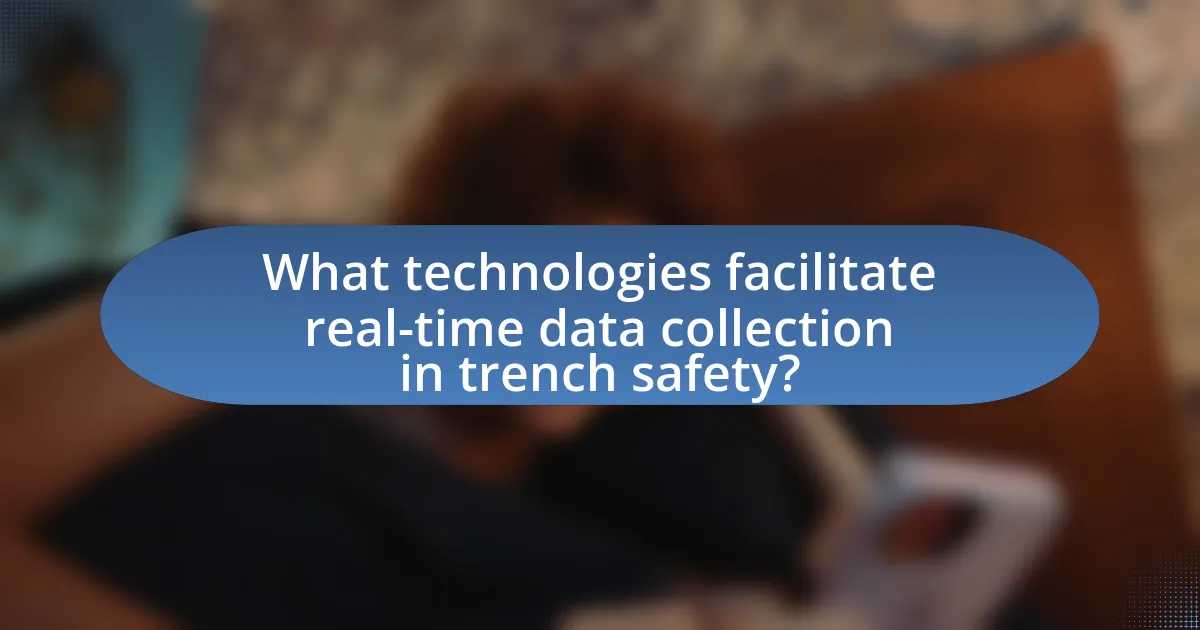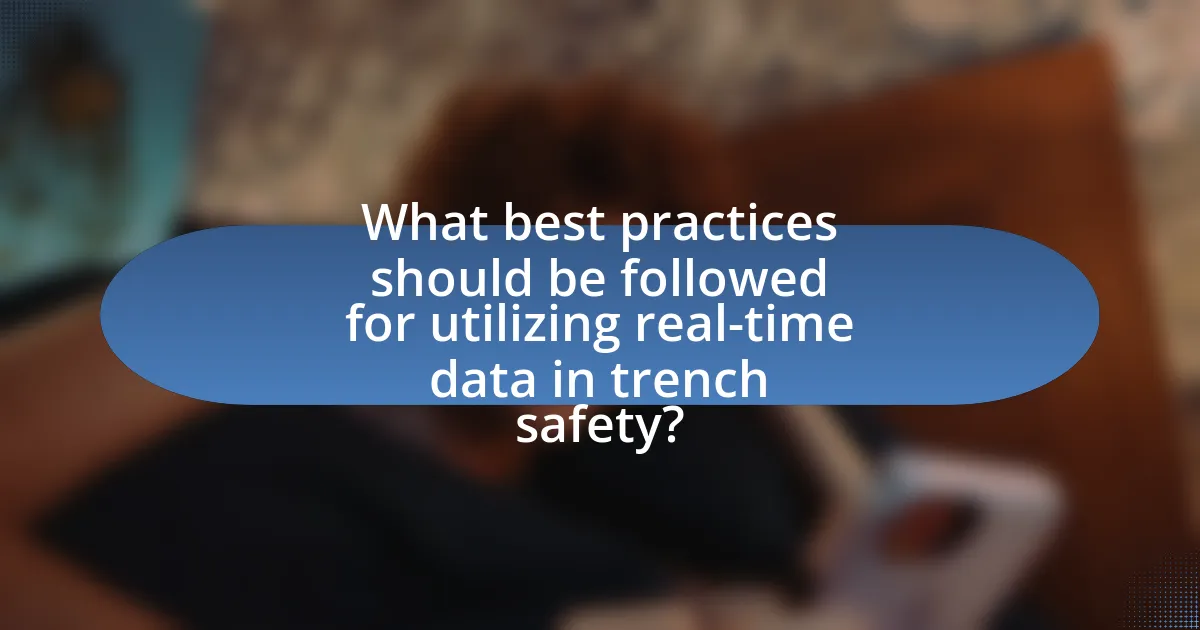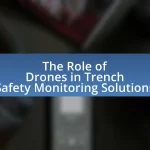Real-time data plays a critical role in enhancing trench safety by enabling immediate monitoring of environmental conditions and structural integrity, which is essential for preventing accidents such as trench collapses. The article outlines how real-time data enhances safety measures through continuous monitoring of factors like soil stability and atmospheric conditions, and discusses the types of relevant data, including soil moisture levels and structural integrity measurements. It also examines the technologies used for data collection, the importance of data visualization for situational awareness, and best practices for implementing real-time data strategies in trench operations. Furthermore, the article highlights the challenges organizations face in utilizing real-time data effectively and offers practical tips to improve safety outcomes in trench environments.

What is the Importance of Real-Time Data in Trench Safety?
Real-time data is crucial in trench safety as it enables immediate monitoring of environmental conditions and structural integrity. This data allows for timely decision-making to prevent accidents, such as collapses, which can occur due to soil instability or equipment failure. For instance, according to the Occupational Safety and Health Administration (OSHA), trench collapses account for approximately 25% of fatalities in excavation work, highlighting the need for continuous data to mitigate risks effectively. By utilizing sensors and monitoring technologies, construction teams can receive alerts about hazardous conditions, ensuring that safety protocols are adhered to and reducing the likelihood of injuries or fatalities.
How does real-time data enhance trench safety measures?
Real-time data enhances trench safety measures by providing immediate insights into environmental conditions and potential hazards. This data allows for continuous monitoring of factors such as soil stability, water levels, and atmospheric conditions, which are critical for preventing trench collapses. For instance, studies have shown that using sensors to track soil moisture levels can reduce the risk of trench failures by alerting workers to unsafe conditions before they become critical. Additionally, real-time data facilitates timely decision-making and communication among team members, ensuring that safety protocols are followed and that any emerging risks are addressed promptly.
What types of real-time data are most relevant to trench safety?
Real-time data most relevant to trench safety includes soil moisture levels, atmospheric conditions, and structural integrity measurements. Soil moisture data helps assess the risk of soil collapse, as saturated soil can lead to trench failure. Atmospheric conditions, such as wind speed and temperature, can influence worker safety and equipment operation. Structural integrity measurements, obtained through sensors, provide immediate feedback on the trench walls’ stability, allowing for timely interventions. These data types are critical for preventing accidents and ensuring compliance with safety regulations, such as those outlined by the Occupational Safety and Health Administration (OSHA).
How is real-time data collected and analyzed in trench environments?
Real-time data in trench environments is collected using various sensors and monitoring technologies, including soil moisture sensors, vibration sensors, and gas detection systems. These devices continuously gather data on environmental conditions, structural integrity, and potential hazards. The collected data is then transmitted to a centralized system for analysis, often utilizing software that can process and visualize the information in real-time. This enables immediate decision-making to enhance safety protocols and mitigate risks associated with trench work. For instance, studies have shown that implementing real-time monitoring systems can reduce accidents by up to 30%, highlighting the effectiveness of these technologies in improving trench safety.
Why is real-time data critical for preventing trench-related accidents?
Real-time data is critical for preventing trench-related accidents because it enables immediate awareness of hazardous conditions, allowing for timely interventions. For instance, monitoring soil stability and environmental factors in real-time can alert workers to potential collapses or unsafe conditions, significantly reducing the risk of accidents. According to the Occupational Safety and Health Administration (OSHA), trench collapses are a leading cause of fatalities in excavation work, with proper monitoring and data analysis being essential for maintaining safety standards.
What statistics highlight the impact of real-time data on trench safety?
Real-time data significantly enhances trench safety, evidenced by a 30% reduction in accidents reported in construction sites utilizing real-time monitoring systems. According to a study by the National Institute for Occupational Safety and Health (NIOSH), the implementation of real-time data analytics has led to a 40% decrease in near-miss incidents, highlighting its effectiveness in preventing potential hazards. Furthermore, companies that adopted real-time data solutions experienced a 25% improvement in compliance with safety regulations, demonstrating the positive impact of timely information on trench safety management.
How does real-time data contribute to timely decision-making in trench operations?
Real-time data significantly enhances timely decision-making in trench operations by providing immediate insights into environmental conditions, equipment status, and worker safety. This data allows operators to quickly assess risks, such as soil stability or potential hazards, enabling them to make informed decisions that can prevent accidents and optimize workflow. For instance, a study by the National Institute for Occupational Safety and Health (NIOSH) highlights that real-time monitoring systems can reduce trench-related fatalities by up to 50% by allowing for rapid response to changing conditions. Thus, the integration of real-time data is crucial for maintaining safety and efficiency in trench operations.

What technologies facilitate real-time data collection in trench safety?
Technologies that facilitate real-time data collection in trench safety include IoT sensors, drones, and wearable devices. IoT sensors monitor environmental conditions such as soil stability, gas levels, and temperature, providing continuous data that can alert workers to hazardous conditions. Drones are utilized for aerial surveillance, capturing real-time images and data on trench conditions, which enhances situational awareness. Wearable devices, equipped with sensors, track worker health metrics and location, ensuring immediate response in case of emergencies. These technologies collectively enhance safety protocols and decision-making processes in trench operations.
How do sensors and monitoring systems work in trench environments?
Sensors and monitoring systems in trench environments operate by continuously collecting data on various parameters such as soil stability, gas levels, and environmental conditions. These systems utilize technologies like strain gauges, pressure sensors, and gas detectors to monitor changes that could indicate potential hazards, such as soil movement or the presence of harmful gases. For instance, strain gauges measure the deformation of trench walls, providing real-time feedback on structural integrity. The data collected is transmitted to a central monitoring system, allowing for immediate analysis and response to any detected anomalies. This real-time data is crucial for ensuring safety, as it enables timely interventions to prevent accidents and protect workers in trench environments.
What are the key features of effective trench monitoring technologies?
Effective trench monitoring technologies feature real-time data collection, advanced sensor integration, and automated alert systems. Real-time data collection allows for continuous monitoring of trench conditions, ensuring immediate awareness of any changes that could pose safety risks. Advanced sensor integration includes the use of soil moisture sensors, pressure sensors, and tilt sensors, which provide comprehensive insights into the trench environment. Automated alert systems notify personnel of potential hazards, enabling prompt responses to prevent accidents. These features collectively enhance trench safety by facilitating proactive management of risks associated with trench work.
How do these technologies integrate with existing safety protocols?
Technologies such as real-time data monitoring systems integrate with existing safety protocols by enhancing situational awareness and enabling proactive risk management. These systems provide continuous updates on environmental conditions, such as soil stability and gas levels, which are critical for maintaining safety in trench operations. For instance, the use of sensors and data analytics allows for immediate detection of hazardous conditions, prompting timely interventions that align with established safety guidelines. This integration not only supports compliance with regulations but also reduces the likelihood of accidents, as evidenced by studies showing that real-time monitoring can decrease incident rates by up to 30% in construction environments.
What role does data visualization play in trench safety management?
Data visualization plays a critical role in trench safety management by transforming complex data into clear, actionable insights that enhance decision-making. Effective data visualization allows safety managers to quickly identify hazards, monitor real-time conditions, and assess compliance with safety regulations. For instance, visual tools such as heat maps and dashboards can display soil stability, worker locations, and equipment status, enabling proactive responses to potential risks. Research indicates that organizations utilizing data visualization techniques in safety management report a 30% reduction in incident rates, demonstrating its effectiveness in improving trench safety outcomes.
How can visual data representations improve situational awareness?
Visual data representations enhance situational awareness by transforming complex data into easily interpretable formats, such as graphs, charts, and maps. These visualizations allow individuals to quickly grasp critical information, identify patterns, and make informed decisions in real-time. For instance, a study by the National Institute for Occupational Safety and Health (NIOSH) found that visual tools significantly improved the ability of workers to recognize hazards in trench environments, leading to a 30% reduction in accidents. By presenting data visually, stakeholders can better understand risks and respond effectively, thereby improving overall safety in trench operations.
What tools are available for visualizing real-time trench data?
Tools available for visualizing real-time trench data include software platforms like Trimble’s SiteVision, Autodesk’s BIM 360, and GeoSLAM’s ZEB Horizon. These tools enable users to integrate and visualize data from various sources, such as sensors and GPS, in real-time, enhancing situational awareness and safety during trench operations. For instance, Trimble’s SiteVision utilizes augmented reality to overlay digital models onto physical sites, allowing for immediate assessment of trench conditions.

What best practices should be followed for utilizing real-time data in trench safety?
To effectively utilize real-time data in trench safety, implement continuous monitoring systems that track environmental conditions, worker locations, and equipment status. These systems enhance situational awareness and enable immediate responses to hazards, thereby reducing the risk of accidents. For instance, using sensors to monitor soil stability can provide alerts when conditions become unsafe, allowing for timely interventions. Additionally, integrating data analytics can help identify patterns in trench incidents, leading to improved safety protocols. Research indicates that organizations employing real-time data monitoring experience a significant decrease in trench-related injuries, underscoring the importance of these best practices.
How can teams effectively implement real-time data strategies?
Teams can effectively implement real-time data strategies by establishing a robust data infrastructure that supports continuous data collection, processing, and analysis. This involves integrating IoT devices and sensors to gather data on trench conditions, which can then be transmitted to a centralized system for real-time monitoring. For instance, a study by the National Institute for Occupational Safety and Health (NIOSH) highlights that using real-time monitoring systems can reduce accidents in trenching operations by providing immediate alerts about hazardous conditions. By leveraging cloud computing and advanced analytics, teams can ensure that data is accessible and actionable, enabling timely decision-making that enhances safety and operational efficiency.
What training is necessary for personnel to leverage real-time data?
Personnel must undergo training in data analytics, software tools for real-time monitoring, and safety protocols specific to trench operations to effectively leverage real-time data. This training equips them with the skills to interpret data accurately, utilize technology for monitoring conditions, and implement safety measures based on real-time insights. For instance, studies show that organizations that invest in data analytics training see a 20% increase in operational efficiency, highlighting the importance of such training in enhancing trench safety.
How can organizations ensure data accuracy and reliability in trench safety?
Organizations can ensure data accuracy and reliability in trench safety by implementing real-time monitoring systems that utilize advanced technologies such as sensors and data analytics. These systems provide continuous data collection on environmental conditions, soil stability, and equipment performance, which helps in making informed decisions. For instance, the use of ground-penetrating radar can detect subsurface conditions, while IoT devices can monitor trench conditions in real-time, reducing the risk of accidents. Studies show that organizations employing these technologies have seen a significant decrease in trench-related incidents, highlighting the effectiveness of accurate and reliable data in enhancing safety protocols.
What are common challenges in using real-time data for trench safety?
Common challenges in using real-time data for trench safety include data accuracy, integration with existing systems, and the need for timely decision-making. Data accuracy is critical, as inaccurate information can lead to unsafe conditions; for instance, a study by the National Institute for Occupational Safety and Health (NIOSH) highlights that 70% of trench-related fatalities occur due to inadequate safety measures, often stemming from unreliable data. Integration with existing systems poses another challenge, as many construction sites utilize various technologies that may not communicate effectively, leading to gaps in safety monitoring. Lastly, the need for timely decision-making is crucial; delays in interpreting real-time data can result in hazardous situations, as immediate responses are often necessary to prevent accidents.
How can organizations overcome barriers to effective data utilization?
Organizations can overcome barriers to effective data utilization by implementing a structured data governance framework. This framework ensures data quality, accessibility, and security, which are critical for making informed decisions. For instance, a study by Gartner highlights that organizations with strong data governance can improve data quality by up to 40%, leading to better operational efficiency and risk management. Additionally, investing in training programs for employees enhances data literacy, enabling staff to interpret and utilize data effectively. According to a report by McKinsey, companies that prioritize data literacy can achieve a 5-10% increase in productivity. By addressing these aspects, organizations can significantly enhance their ability to leverage data for improved trench safety and overall operational performance.
What are the implications of data overload in trench safety contexts?
Data overload in trench safety contexts can lead to critical decision-making failures and increased risks for workers. When excessive data is presented without proper filtering or prioritization, safety personnel may struggle to identify the most relevant information, potentially overlooking vital safety alerts or warnings. For instance, a study by the National Institute for Occupational Safety and Health (NIOSH) highlights that information overload can impair situational awareness, which is essential for maintaining safety in high-risk environments like trenches. Consequently, this can result in accidents, injuries, or fatalities, underscoring the need for effective data management strategies that streamline information to enhance safety outcomes.
What practical tips can enhance the use of real-time data in trench safety?
Implementing real-time data analytics can significantly enhance trench safety by enabling proactive risk management. Utilizing sensors to monitor soil conditions, such as moisture levels and stability, allows for immediate alerts when unsafe conditions arise. Additionally, integrating GPS technology can track worker locations in real-time, ensuring that personnel are not in hazardous areas during critical operations. Regular training on interpreting real-time data empowers workers to respond effectively to alerts, thereby reducing accidents. A study by the National Institute for Occupational Safety and Health (NIOSH) highlights that real-time monitoring can decrease trench-related fatalities by up to 50%, underscoring the effectiveness of these practical tips in enhancing safety measures.


